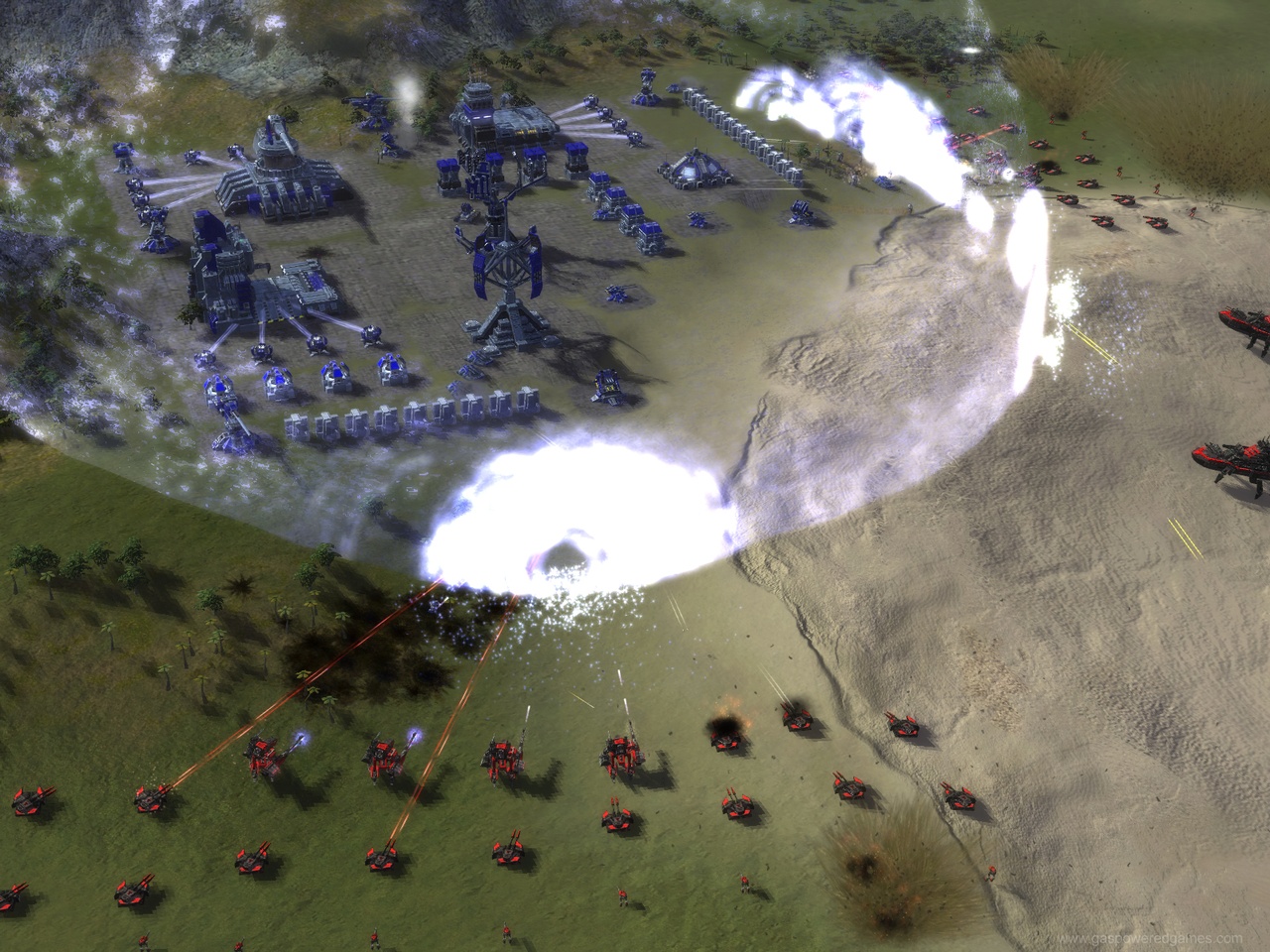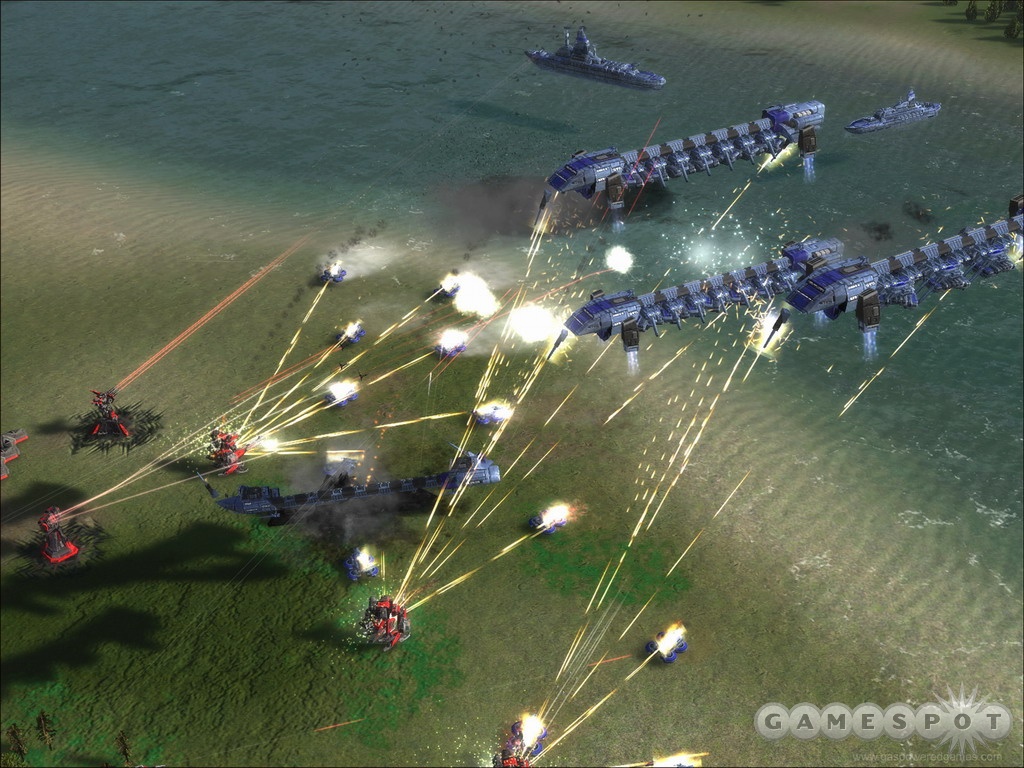Supreme Commander Updated Q&A - Army Size, Strategic View, and Nuclear Warfare
Creator Chris Taylor returns to talk about the scale of this humongous real-time strategy game.
If you've ever felt that the maps in most real-time strategy games were too small for your ambitions, then you'll most definitely want to keep an eye out for Supreme Commander, the upcoming RTS game that will redefine the concept of scale. Set in a distant future, Supreme Commander boasts battlefields that are thousands of square kilometers in size, which means that you have room to let your imagination go. For instance, instead of launching a head-on attack against an enemy position, you might secretly move battle groups behind enemy lines to launch a coordinated attack from the rear. And for good measure, you can soften up enemy defenses with waves of air strikes, artillery barrages, and even nuclear weapons. With the game due to arrive in February, we caught up with creator Chris Taylor to find out more about Supreme Commander.
GameSpot: How many worlds are there to fight on, and what are the different environments? Does environment have any impact at all on gameplay? For instance, is there any substantial difference between fighting it out on snow and fighting it out in a desert?

Chris Taylor: We have seven different environments, and although the environments' art styles don't impact the game, the way the maps are laid out topographically does. The most important aspects of the terrain that players will want to consider when playing is high mountains, cliffs, and water. It's a good idea to scout the map early on, especially if you haven't played on it before, and be especially wary of where units can access the water. For example, units like the Cybran destroyer can't crawl up a sheer bluff, and you'll need to find a less extreme grade.
GS: Just how many units can be onscreen at once (land, sea, and air)? How is the game being optimized to scale these massive battles for computers with different specifications?
CT: Currently, we have set the unit maximum to 500, but we never expect to have all those units on the screen, rendered at the highest detail, at once. We expect the number to be lower in the typical gameplay situation. The easiest way to manage the extreme differences between fast PCs and slower ones is to allow for a lot of different rendering options. Those who have the more powerful PCs will be able to crank up all the shader effects and turn on the higher-detailed shadows, to name a few of the options.
GS: There are maps that are thousands of square kilometers in size. Are you afraid that some people might be scared by that? Do you have to wait a lot for units to cover large distances? Will there be any kind of time acceleration to speed up parts of the game?
CT: Those extremely large maps are included to give players a taste of what is to come in the future. I believe that a truly strategic game needs to take place on much larger maps than what we typically see today. I think most players will quickly get used to the larger map sizes of Supreme Commander, where they can truly "spread their strategic wings," so to speak. Additionally, we have added a new feature, called the ferry system, which allows players to use air transports to move units around automatically. This really changes the dynamics on those larger maps, as well.

GS: Tell us more about the strategic view in the game, which is used to keep an eye on the big picture. It sounds like the minimap is dead and the strategic view is now king. Can you play entirely from this view? And it sounds like you can customize this view in all sorts of interesting ways.
CT: Well, you can do quite a lot from the strategic view, but it's not where you want to play the whole game. However, over time, there are some players who may master that mode of play, despite the fact that we never really intended for the whole game to be played that way. In terms of customizations, we have a few interesting things going on. We have the customizable position of the user interface (bottom, left, and right sides of screen), and we have the ability to split the main view and to hide the minimap so that you can save a little processing power. You can also run the dual-screen mode, so there are a lot of ways to set up the game.
GS: Will we get day and night cycles in the game? Will you be able to use darkness to hide units? Or is everything going to be fought in the light of day?
CT: I made an early decision not to design a day and night cycle, but we might do something with that play mode in the future.
GS: Tell us about what sorts of tools and features players will have to manage these battles, especially ones that involve mixed forces of land and sea troops. Will players have to constantly zoom in and out of the larger map views?
CT: Zooming is a big part of the game, but it's really something that each player does on a personal basis. Some players zoom in and out constantly, whereas others use it much less often. But in each case, it's easy to watch how each player does it seamlessly. It takes someone about 10 minutes before they have mastered this interface. The game's overall interface is very familiar to most RTS players, so we really haven't introduced any concepts that are alien or hard to comprehend.
GS: The ranges on some of the biggest artillery pieces are truly frightening. You can hit any part of the map with some of the biggest guns, which raises the question: How do you counter something like this? What's to prevent you from sitting back behind layers of defenses and pounding your opponent?
CT: If you allow your opponent to build a massive gun, like the mavor, for example, then it might be a good time to launch a counteroffensive with your own experimental weapon! However, if you aren't quite ready to hatch your master plan, you definitely will want to build lots of shield systems to protect your base.
GS: Everyone loves a good nuclear explosion, but is there any downside to nuclear warfare? Is everything basically a race to get to the nukes first? Do nukes basically represent the end-stage of a game?
CT: Nukes are truly awesome, but they are only a game-ender if you don't build any kind of protection against them. And also bear in mind that they are very expensive and make for a very interesting late-game resource-allocation decision. For example, while you are building nukes, which may or may not win you the game, what has your opponent been building all this time?

GS: OK, let's say that you're playing on a huge map but losing. The other side has numerical superiority, along with a larger economy. In this case, is it all but inevitable that the strong side keeps getting stronger? How is the game designed so the losing player can turn things around?
CT: I have heard some great stories about players coming back from the brink of destruction, but it is a rare occurrence. Here's a situation that's not far fetched: Your opponent launches a massive attack and almost wipes you off the map, but you were moments away from completing an experimental unit that manages to survive the assault and gets completed before your opponent can execute a final attack. You unleash this behemoth and inflict enough damage on your opponent to "even" the playing field, giving you more than enough time to come back from the edge or take it all the way home and put the other player away for good--all very real possibilities when playing Supreme Commander. In a nutshell, the experimental units make anything possible.
GS: Thanks, as always, Chris.
Got a news tip or want to contact us directly? Email news@gamespot.com
Join the conversation